Object detection is a process used to detect and recognize various objects available in video or images and label them for classification. Object detection uses various algorithms to perform localization and recognition of the object such as yolo object detection, and all these algorithms use deep learning to develop meaningful results. However, many organizations provide a Ready-made Object Detector Project which reduces the efforts of writing the code from scratch.
Object detection
The technique of detection, localization, and recognition of the multiple virtual examples of an object in the video or image is known as Object detection. It offers us a comprehensive knowledge of the objects rather than just a single basic classification. This technique is used to counter the no. of instances of different objects and make precise locations with the labeling. The performance of this technique has improved with time, which helps with real-time use.
What is an Object?
An object is defined as an element that can represent visually. The characteristics of the object don’t have a wide range of variability. It must be semi-rigid to differentiate and detect.
How is object detection done?
The development of object detection has undergone two significant changes during the past 20 years; the traditional method to detect objects was used between 2000 to 2014, and Deep learning-based detection was used after 2014.
During the early 2000s, the technical evolution of object detection started. In the initial phases, they followed the mid-level and low-level vision and the technique of ‘recognition-by-components.’ Object detection is done by measuring the similarity between various objects, such as components, contours, and shapes. The core features considered are distance, shape, edgeless, and contexts. Later, machine detection methods came into the picture to overcome this issue.
Multi-scale detection of objects was performed by considering objects with “different aspect ratios” and “different sizes.” It was one of the significant technical challenges faced by the programs in the early phase of the development of object detection. In 2014, this issue was solved with the advances in technology. The second detection phase is later referred to as Deep learning.
Concept
The features are the main concept behind this process. The features can assist you in segregating different objects. The feature used to classify one object from another is Object detection methodology. A similar concept is utilized for fingerprint detection, face detection etc.
What is Object Detection?
An object is a procedure of determining all the probable instances of the real world, such as flowers, cars, human faces, etc., in videos or images, in real-time with the most accuracy. The actual applications of object detection are security and surveillance, image retrieval, advanced driver assistance system (ADAS), and many more.
Description of Object Description
As humans, we can detect various materials and objects in front of our eyes and identify them accurately. Being human beings, its relatively easy for us to identify and count objects without making an effort. The development of the technologies has resulted in the significant availability of the data to make efficient algorithms and make PCs and programs perform the same task of detection and classifications of objects.
Numerous terms are associated with object recognition, such as object localization, computer vision, object classification, etc.
- Computer Vision: The field of AI allows us to train computers to interpret and understand the visuals of videos and images using models and algorithms.
- Image Classification: This step consists of labeling and detecting the images with the help of artificial intelligence. These images are classified on the basis of the inputs provided by the users.
- Object Localization: This step consists of detecting the various objects in provided visuals and making a boundary around them, especially a box.
- Object Detection: It consists of both processes and classifies the objects. Then it draws boundaries for each object & labels them as per the features.
How does Object Detection work?
We can assume that you are quite familiar with object detection. There are numerous approaches, but generally, we follow two approaches, i.e., Deep Learning and Machine Learning. You can Install & Run these programs on your system. So, here in this article, we will thoroughly go through both learning process.
Methods for Object Detection
As we have read above, there are two approaches to object detection; Deep Learning, and Machine Learning. In the Machine Learning approach, the required feature is defined using different approaches and techniques like Support Vector Machines to classify. In comparison, Deep Learning makes complete procedures without explicitly defining features for classification. The Convolutional Neural network is the approach to the deep learning process.
What is Machine Learning Approach?
Machine Learning is an application of AI that makes the computer learn from the data given and make independent decisions like human beings. It allows computers to make a prediction and learn based on information and data, which is loaded to it through real-world observation and interactions. It is the procedure of using the algorithm for data analyses and then making predictions based on provided data. Machine learning algorithms could make decisions by themselves without being pre-programmed for it. Email Spam filtering, voice assistant, and product recommendations are some day-to-day examples of the machine learning program.
What is Deep Learning?
Deep Learning, also called Deep Structure learning, is a class of machine learning algorithms. It uses multi-layer approaches to extract the high-level features from the provided data. It does not require any manual data classification, and it tries to transfer data to the abstract representation. It is influenced by artificial neural networks, which are present in human brains. Fraud news detection, natural language processing, and visual recognition are some of the day-to-day applications of deep learning.
Conclusion
So, if you plan to build your career in machine learning or deep learning, you can choose any of the abovementioned paths. The demand for deep learning is increasing daily, and it has the maximum growth opportunities in the future. kandi from Open Weaver provides a Ready-made Object Detector Project, making your work seamless and easy. You only need to Install & Run the program.
































